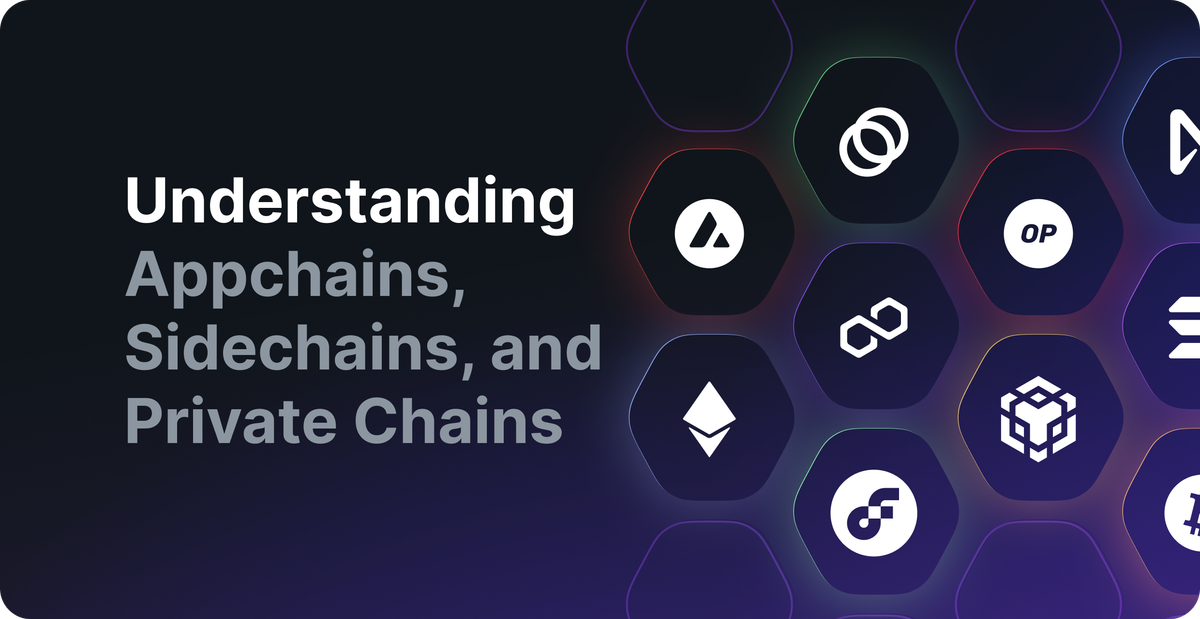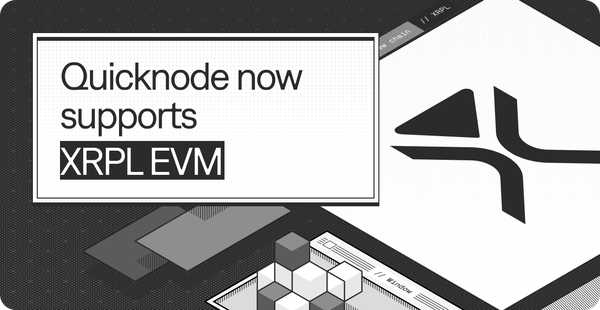Understanding Appchains, Sidechains, and Private Chains
Discover the transformative power of blockchain technology, from enhancing scalability with modular solutions like appchains and sidechains to optimizing performance across various sectors.

The meaning of blockchain has evolved from Satoshi’s “peer-to-peer system for digital cash” to date. The applications of blockchain have grown exponentially and rightfully, the infrastructure needs more capacity to accommodate the new use cases, more users, and higher activity levels.
This was on display in April 2021 when Ethereum was overloaded with on-chain activity, and the gas fees shot up to astronomical levels. To avoid these issues and build a more efficient and inexpensive blockchain infrastructure, the modularity thesis continues to gain significant attention and praise.
The essence of the modularity thesis can be summarized as “rather than scaling a single L1 for various protocols, create individual optimized L1s for each and interconnect them."
We will be covering modular blockchains in detail within this dedicated series.
In the first installment, we uncover the popular fruits of this modularity thesis, namely, appchains, sidechains, and private chains. The second part will focus onrollups and how they enable composable scalability of blockchains. In the third part, we will discuss data availability solutions.
This blog is the first part of the series where we aim to provide a deeper understanding of appchain solutions, their benefits, and how web3-native projects and traditional enterprises alike are making use of them.
Types of blockchain: Appchains, Sidechains, and Private Chains
Before we delve into the specifics, we should remember that scalability is the common goal and each solution here is a different approach to reaching that goal. Going by the modularity thesis, the popular solutions aim to tailor blockchains to specific needs and requirements.
As an overview, this is how each of them works.
- Appchains are specialized blockchains tailored for individual use cases, ensuring optimal performance and maximum customizability for a given application set
- Sidechains run parallel to main chains, enhancing scalability without compromising the primary network.
- Private blockchains offer controlled access, catering to businesses seeking customized security, performance, and privacy.
In the coming sections, we will dive deeper into each of these solutions and how they help in scaling Ethereum.
What are Appchains?
Appchains are specialized blockchains designed for a specific application. Unlike public blockchains, Appchains focus on a single use case, ensuring optimal performance.
They're customizable, allowing developers to select specific parameters, from consensus mechanisms to governance models. With dedicated resources, Appchains enjoy faster transactions, reduced bottlenecks, scalability, and often more cost-effective operations without the usual gas fee spikes.
Benefits of Appchains
Sovereignty: Appchains function autonomously, reducing dependencies and guarding against potential disruptions from external blockchain systems.
Customization: They provide developers with an optimized and adaptable blockchain environment tailored to unique needs.
Scalability: They handle growing transactions and users efficiently, ensuring smooth and efficient performance by reducing network congestion and controlling transaction costs
Appchain solutions
Polkadot's parachains are specialized blockchains within its ecosystem, optimized for particular tasks and secured by its Relay Chain.
dYdX v4, built on the Cosmos SDK, exemplifies appchains' potential, offering unique customization and decentralizing their order book and matching engine, surpassing other blockchain networks.
Avalanche subnets are a scalability solution within the Avalanche platform that offers unparalleled customization. AVAX subnets allow developers to employ distinct consensus algorithms tailored to their specific use cases. All subnets remain interoperable, enabling seamless asset and data transfers across the Avalanche ecosystem.
What are Sidechains?
A sidechain is an independent blockchain that works alongside a primary or "main" blockchain. Connected through a two-way bridge, it transfers assets back and forth between the main chain and the sidechain.
While each sidechain has its unique consensus mechanism and protocols, it's designed to offload tasks or transactions from the main chain, enhancing scalability.
More importantly, the sidechain’s decentralization ensures that even if a sidechain is compromised, the leading blockchain remains unaffected.
How?
Sidechains are decentralized, courtesy of their validator nodes and consensus mechanisms. This reduces single points of failure, enhancing security. If issues arise, they're contained within the sidechain, safeguarding the main blockchain.
This design protects both chains, preventing cascading compromises from one environment to the other.
Benefits of Sidechains
Enhanced scalability and cost-efficiency: Sidechains offload transactions from the main chain, optimizing speed and reducing user costs.
Seamless experimentation and upgrades: They allow for testing and deploying new features without disrupting the main blockchain.
Expanded blockchain functionality: They enable developers to introduce and test new dApps or features not supported by the parent network.
Sidechain solutions
Polygon PoS (proof of stake) is an Ethereum sidechain designed as a scalability solution for Ethereum by offering faster and more cost-effective transactions.
Additionally, its framework allows for effortless asset transfers between the main Ethereum chain and multiple chains within the Polygon ecosystem.
Bitcoin Liquid network is a sidechain developed by Blockstream to improve the liquidity of Bitcoin transactions between exchanges and brokers.
This sidechain allows for asset issuance, paving the way for tokenized assets and stablecoins on its platform.
Gnosis Chain is one of the first sidechains of Ethereum, secured by over 140,000 validators. Built on this is GnosisPay, a payment service that enables users to pay and receive cryptocurrencies peer-to-peer while still being compatible with traditional payment methods.
What are Private Chains?
Private blockchains, also known as permission blockchains, are restricted networks where participation is invite-only. Unlike public blockchains, which are open for anyone to join and validate transactions, private blockchains are controlled by a single entity or a consortium.
This centralized approach ensures enhanced privacy, security, and faster transaction speeds but sacrifices the decentralized ethos of public blockchains.
Benefits of Private Chains
Security & trust: Private blockchains offer an unparalleled degree of control, which, in turn, adds to the network’s security.
Performance & throughput: Validation times are low in private blockchains, thanks to the presence of a limited number of validators. This ensures higher transaction speeds and throughput.
Privacy & regulatory compliance: They ensure that sensitive information remains confidential. This helps businesses meet governmental regulatory and data protection needs.
Private Chain solutions
Hyperledger Besu is an Ethereum client software that enables enterprise-level applications on Ethereum. It offers composable features like privacy, permissioning, and consensus choices, which are a must-have to build private blockchain networks.
The Brazilian Central Bank is employing a permissioned version of Hyperledger Besu for their pilot program of their digital currency, DREX.
Quorum is an enterprise-focused, permissioned blockchain platform developed by JP Morgan. It is used to settle securities transactions, track cross-border payments, and maintain interbank payment networks.
Final thoughts: Modularity is the future
Modularity in blockchain represents the future of the technology, offering solutions that cater to specific needs while ensuring scalability, interoperability, and customization. As the blockchain space continues to grow, adaptability will be paramount. Chains that can scale to meet the demands of diverse applications will thrive, and those that can't will be left behind.
The rise of appchains, sidechains, and private chains highlights the industry's move toward specialization and optimization. Each of these solutions brings its own set of advantages, catering to different sectors and use cases.
As more projects adopt these modular solutions, the industry will become more resilient, dynamic, and capable of supporting the ever-evolving landscape of decentralized applications.
Ready to bring your blockchain vision to life? QuickNode offers the ultimate platform for building custom, scalable blockchains with zero infrastructure stress. Our fully managed, dedicated chains provide the foundation for innovation, supporting leading protocols like Polygon CDK, zkSync ZK Stack, and more. With QuickNode's battle-tested infrastructure, including advanced block explorer, validator tools, and scalable RPC, you can focus on creating exceptional user experiences while we handle the technical heavy lifting. Launch your blockchain project with ease and confidence, backed by 24/7 support and a suite of developer-friendly tools.
If you’re curious about getting started on Appchains, get in touch with us here 👇
About QuickNode
QuickNode is building infrastructure to support the future of Web3. Since 2017, we've worked with hundreds of developers and companies, helping scale dApps and providing high-performance access to 25+ blockchains. Subscribe to our newsletter for more content like this, and stay in the loop with what's happening in Web3!





